Oh noes! TC built a grey jet!
Done for a customer. The only 5th generation jet I find interesting. Definitely a beautiful design,
Given my complete lack of knowledge about the Rafale, I will quote here from Wikipedia:
The Dassault Rafale is a twin‑engine delta‑wing fighter aircraft designed and built by Dassault Aviation as an omnirole fighter with semi‑stealth capabilities. The Rafale is a multi-role combat aircraft; capable of simultaneously undertaking air supremacy, interdiction, reconnaissance, and airborne nuclear deterrent missions. The Rafale is distinct from other European fighters of its era in that it is almost entirely built by one country, involving most of France's major defense contractors, such as Dassault, Thales and Safran.
In the late 1970s, the French Air Force and Navy were seeking to replace and consolidate their current fleets of aircraft. In order to reduce development costs and boost prospective sales, France entered into an arrangement with four other European nations to produce an agile multi‑purpose fighter, but subsequent disagreements over work share and differing requirements led to France's pursuit of its own development program. Dassault built a technology demonstrator which first flew in July 1986 as part of a eight‑year flight‑test program, paving the way for the go ahead of the project.
The Rafale's design and production processes exploits the unprecedented advancements in software technology; these have enabled the integration of formerly individual components and combined with automated analysis processes, known collectively as data fusion. Many of the aircraft's avionics and features, such as direct voice input (DVI), the RBE2 AA active electronically scanned array (AESA) radar and the Optronique secteur frontal (OSF) infra‑red search and track sensor, were indigenously developed and produced for the Rafale program. Originally scheduled to enter service in 1996, post‑Cold War budget cuts and changes in priorities contributed to significant delays.
Introduced in 2001, the Rafale is produced for both the French Air Force and for carrier‑based operations in the French Navy. In December 2000, the French Naval Aviation (Aéronavale)received its first two Rafale Ms. The following year, Flottille 17F was re‑activated prior to the delivery of the sixth Rafale, thus becoming the first squadron to operate the type; the squadron had previously operated the F‑8 Crusader.[Flottille 17F immediately participated in Trident d'Or aboard the aircraft carrier Charles de Gaulle with warships from ten other nations. After almost four years of training, the Rafale M was declared operational with the French Navy in June 2004.
The Rafale M is fully compatible with US Navy aircraft carriers and some French Navy pilots have qualified to fly the aircraft from US Navy flight decks. On 4 June 2010, during an exercise on the USS Harry S. Truman (CVN‑75), a French Rafale became the first jet fighter of a foreign navy to have its engine replaced on board an American aircraft carrier.
In 2002, the Rafales were first deployed to a combat zone; seven Rafale Ms embarked aboard the Charles de Gaulle of during "Mission Héraclès", the French participation in "Operation Enduring Freedom". They flew from the aircraft carrier over Afghanistan, but Rafale did not see any action. In June 2002, while Charles de Gaulle was in the Arabian Sea, Rafales conducted several patrols near the India‑Pakistan border.
In 2007, after a "crash program" enhancement, six Rafales were given the ability to drop laser‑guided bombs. Three Air Force aircraft were deployed to Dushanbe in Tajikistan, while the three Rafale-Ms went on board the Charles De Gaulle. The first mission occurred on 12 March 2007, and the first GBU‑12 was launched on 28 March in support of embattled Dutch troops in Southern Afghanistan, marking the operational début of the Rafale. Between January 2009 and December 2011, a minimum of three Rafales were stationed at Kandahar International Airport to conduct combat operations in support of NATO ground forces.
On 19 March 2011, French Rafales began conducting reconnaissance and strike missions over Libya in Opération Harmattan; initial targets were artillery pieces laying siege around the rebel city of Benghazi. The Rafale could operate in Libya using the onboard Spectra self‑defense system. On 24 March 2011, it was reported that a Rafale had destroyed a Libyan Air Force G‑2/Galeb light attack/trainer aircraft on the runway. The Rafale would typically conduct six‑hour sorties, carrying an armament of four MICA air‑to‑air missiles, four or six AASM "Hammer" bombs, a Thales Damoclès targeting pod and two drop tanks;these patrols required multiple aerial refueling operations per sortie from coalition tanker aircraft.The AASM precision‑guidance weapon system, using bombs weighing between 125 kilograms (275.6 lb) and 1,000 kilograms (2,204.6 lb), allowed the Rafale to conduct high‑altitude bombing missions. Reportedly, Rafale crews preferred to use GPS‑guided munitions due to greater reliability and range.
In January 2013, the Rafale took part in "Opération Serval", the French military intervention in support to the government of Mali against the Movement for Oneness and Jihad in West Africa. The first mission was carried out on 13 January, when four Rafales took off from an airbase in France to strike rebel training camps, depots and facilities in the city of Gao, eastern Mali. Subsequent air strikes in the following days by Rafale and Mirage fighters were reportedly instrumental in the withdrawl of Islamist militant forces from Timbuktu and Douentza. Both Rafale and Mirage 2000D aircraft used in the conflict have been based outside of North Africa, making use of aerial refuelling tanker aircraft to fly long range sorties across Algerian airspace and into Mali.
THE KIT
This kit from Ace Ace Corporation/Kawai of Korea is the Revell Rafale kit reboxed, which is confirmed by the Revell stamp inside the wing. This likely confirms that Ace did the original production for Revell. What is important is that it has a re‑tooled top fuselage which has the flare dispensers molded on, which means a current M version can be built without resorting to aftermarket for the fix. The only drop tanks included are the large sized ones; the 4 MICA missiles and 2 MAGIC missiles are included, though the new pylons and bombs are not included. Assembly instructions are entirely in Korean, but are well‑illustrated and easy to follow. Decals provide markings for three aircraft, though the grey “Marine” and aircraft number decals are not a light enough shade of grey to stand out properly if one paints the airplane in Sea Grey Medium, which is the proper color.
CONSTRUCTION
Overall, the model is simple. I understand there is a resin cockpit that was created for the Revell kit, which would go a long way to improving on the very basic cockpit provided in the kit. I decided to close the canopy, which is very clear and allows you to see what is in there without destroying the flowing lines of the airframe.
Fit is excellent, and I only had a gap to fill with cyanoacrylate glue along the lower wing-fuselage joints. Other than that, no putty or other filler was required. I assembled the canard aimed down, which is the position photos show it in when parked.
Assembly of the main landing gear requires it to be placed in the wheel wells prior to attaching the wheel well to the lower fuselage half. This really wasn't a problem, since I hand-painted the gear leg later.
COLORS & MARKINGS
Having found a photo of Rafales in flight to Mali, that showed the airplanes have a finish that can become worn like the USN Tactical Paint Scheme, I pre-shaded the model with flat black along panel lines. I then gave it an overall coat of Tamiya's new “Sea Grey Medium”, with Gunze “Light Aircraft Grey” for the wheel wells and intake trunking. I lightened the paint and went back over the model blotching it to get a multi-hue funish. The six missiles were also painted with “Light Aircraft Grey.”
The decals went on without problem, though as mentioned above the grey markings were too dark to really give the proper contrast shown in photos.
I unmasked the canopy and attached the other clear parts, then attached the nose gear and the detail parts of the main gear and the wheels.
CONCLUSIONS
Well, I think this project confirms my long-held belief that the man who says he can't be bought has not been offered a sufficient price. It was fun building this for the client. I quite like the aesthetics of the Rafale, particularly when compared with the EFA Typhoon II. Those modelers who like modern grey jets can have a lot of fun with this simple, easy to build model.

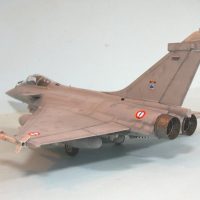

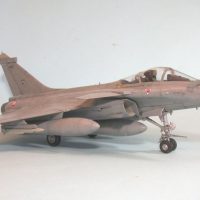
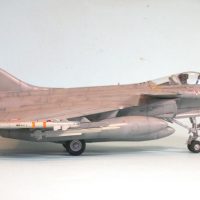
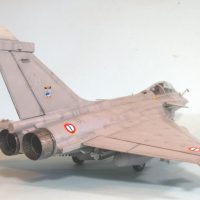
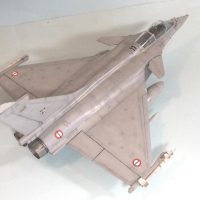
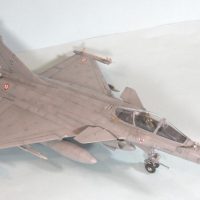
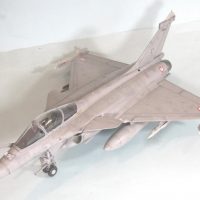


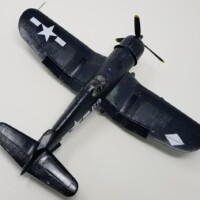
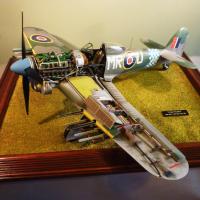
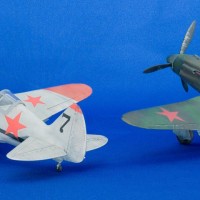
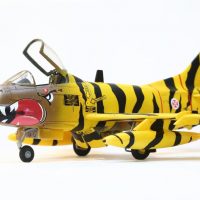
Very nice grey jet! Great back round info as well.
Nice lawn dart. The ordinance looks like a lot of work.
Very nice model Tom. I saw a Rafale flying very, very low Dipping in and out of the Meuse river valley on one side of the border Between France and Belgium by Sedan while on the Belgian side of the border our aging F-16 ‘s were doing the same Work. It was A high speed hair raising Event and I was glad to see this Happening. Not sure it was coordinated but impressive .
Belgium opted for the F-35 to replace the F-16. I hope this was a wise choice.
I guess this was to integrate with other airforces Into the smart grid of air defence. like the Netherlands , Denmark and Norway And Of course Britain which will be formidable.
Maybe the Rafale will hold its own over time . Having 2 engines is better than one. Especially for Carrier operations. Navy’s like 2 motored airplanes. Just in case...
Thank you.
F-35 - the flying Swiss Army knife. Not the product of people like Kelly Johnson, who would be embarrassed it takes its name from his masterpiece. Rather the product of morons with MBAs who know the price of everything and the value of nothing, and think that delivering an airplane that has to be constantly "upgraded" to get it to what it was supposed to be capable of originally is a "profit stream." The good news is, it's the last third-rate product the US will be able to strongarm the rest of the world to accept, since we won't be strongarming anyone anymore.
Hi Tom. Yes, we are taking a huge risk with this F-35 . If it can hold its own it will dominate everything . On the other hand the complicated multi- level awareness it advocates to have as an advantage may also be a weakness and too much to handle for humans. Entering the future it may be the last manned aircraft we will ever see. Makes me think of Skynet. Courtesy the “ Terminator “
Movie.
Thank you. go Rafale !
It does have nice lines Tom. It is a pity this is spoilt by all those external fuel tanks required to give it enough range to join the circuit to land immediately after take off?
That sound like the short legged Hornets.
Excellent model Tom. I hope you got a really good buck for this as it's really, really good work. Very clean build and super shading. 'Bit glossier than I would have expected, but sure you know far more than I.
Nice work, Tom. Rafale is my favorite modern jet too.
Your customer will be very happy with the result, Tom.
This Rafale came out really nice.
The weathering is impressive.
That's a great Rafale, Tom. Having seen this lady "up, close and personal", I can definitely state you got it perfect!
I love the combination of A/A ordnance with 4 MICA EM and 2 MAGIC IR. There are also newer IRs, the MICA IR, but the MAGIC is still a very good missile. This is a seriously A/A armed bad bird! Those fuel tanks would give it more than 4 hour autonomy (comparing similar data from the M2000), without inflight refuelling.
The Rafale is a nice proven and adequately evolved plane, not the cheapest one, but a potent package anyway.
Thanks for the "knowledgeable review" my friend.
Hi Tom,
As Frenchman, I am more than happy you built this Dassault’s bird. As always, you did a nice and well balanced job, bravo!
The poor success of the Rafale abroad is due to political reasons, not technical. I guess it is a non-sense that many european countries selected the F-35 instead (not fully operational yet, one engine only, many technical problems unsolved and high price). One can wonder about the need of the European parlament ?
Anyway, congratulations again for this beautiful rendition!
One of my favorite aircraft out there, very nice build Tom.
When you have a great model of a great looking aircraft there's nothing wrong with 'Grey on Grey'. Kinda makes you focus on the aircraft itself.
Nice weather highlighting job on a good looking bird.
You did a great job bringing the tactical gray scheme to life! I also think the Rafale is one of the more beautiful of the 5-gen jets - it's also the only one I've built so far though I have the others in the stash.
It's great to see how all of you have such great taste! 🙂
I built the Heller version of the Rafale in the Dassault house colors back in the 90's. So there's that if you like the shape of the Rafale, but don't want to do a grey jet.
I built the Heller version of the Rafale in the Dassault house colors back in the 90's. So there's that if you like the shape of the Rafale, but don't want to do a grey jet. You've broken up the grey just enough on this so at least it doesn't look monotone. (A skill I'm still working on.)
Nice. I really like the finish.
Beautiful aircraft and a great looking model!
Nice work, Tom. They take a little different mindset, I've found. I've done a few jets and they're beginning to grow on me.
Some of them do.